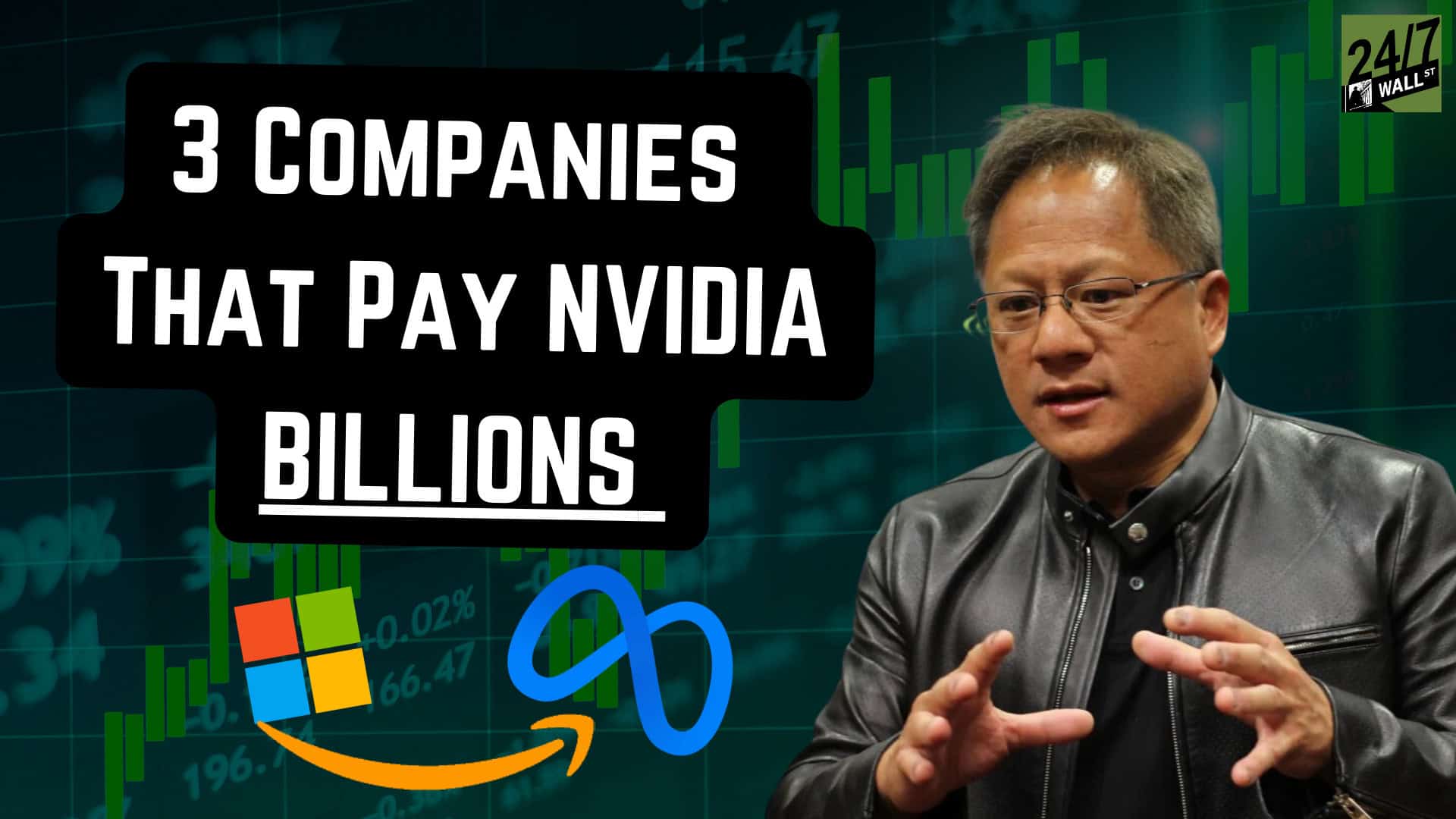
NVIDIA (Nasdaq: NVDA) saw its Data Center group revenues soar by 427% last quarter, but who is buying all of those chips? We dive deep into who NVIDIA’s largest customers are and look at how this concentration has delivered huge amounts of growth but is also a risk that investors need to be on the lookout for.
NVIDIA’s 3 Largest Customers
Here are some of the main points from this discussion between 24/7 Wall Street Analysts Eric Bleeker and Austin Smith.
- NVIDIA has been the center of the stock universe again this week. It hosted its Annual Shareholder meeting where it talked up a plan to target $50 trillion in heavy industry.
- Its shares continue to bounce up and down at very volatile rates. Watching all this got us thinking about just who paying NVIDIA all the money they’re making.
- NVIDIA certainly has some very large companies, and it’s important to understand who they are, as the spending from these customers is the number one driver of the company’s stock performance.
- So, let’s go through the background. In a 10-Q form recently filed by NVIDIA, the company added some disclosures about their customers.
- First, NVIDIA revealed that a single customer contributed 19% of revenues last year.
- Second, the company revealed in the first quarter two customers comprised 24% of total revenue, with one at 13% and another at 11%.
- Now, NVIDIA didn’t name names, but the 19% customer last year (NVIDIA’s largest) is very likely Microsoft.
- In general, the leading customers of NVIDIA right now are cloud computing providers – what are known as “hyperscalers.”
- In 2023 this market had Amazon (Nasdaq: AMZN) at 32% market share, Microsoft (Nasdaq: MSFT) at 22%, and Google (Nasdaq: GOOG) at 11%. Now, those market share numbers don’t tell the whole story. Google has been winning a lot of business from AI customers, while Microsoft has been growing quite a bit faster than Amazon.
- So, just be aware that all these companies are buying a lot of GPUs from NVIDIA and also working on their own custom chips for AI workloads at the same time.
- The other major customer to be aware of is Meta (Nasdaq: META), and they’re probably NVIDIA’s second-largest customer.
- Meta has been very open about their investment in AI computing and recently shared they’re planning “600,000 H100 equivalents” by year’s end. That number includes several types of chips, but Mark Zuckerberg told the Verge the company will own more than 340,000 H100 chips by the end of the year.
- That’s probably somewhere in the neighborhood of about $10 billion in spending just on H100s alone.
- And of course, NVIDIA will begin shipping Blackwell chips later this year too.
- So, if we look at third-party estimates we arrive at NVIDIA’s top 3 customers contributing somewhere a little north of 30% of sales in the fourth quarter. If we expand that to four customers in order – Microsoft, Meta, Google, and Amazon – we get closer to 40% of sales.
- What does all this mean? Well, it means if you’re an NVIDIA investor, you need to be paying very close attention to what these customers are saying about their data center spend!
- Because the number one threat to NVIDIA is them cutting back on orders.
- For now, though, the number one trend driving NVIDIA stock is these big hyperscalers continuing to place big orders for H100s, and indicating strong demand for the company’s Blackwell chips which will launch later this year.
Transcript:
Eric, NVIDIA has been the center of the investment universe once again this week.
So it hosted its annual shareholder meeting, which I know you tune into and pay a lot of attention to.
And it talked of its plan to target $50 trillion in heavy industry.
Now, that is a big number.
And NVIDIA shares continue to bounce up and down at very volatile rates.
But watching all this got me thinking, just who is paying NVIDIA all the money they’re making?
So I was wondering if you could walk me through what we know about NVIDIA’s current customer profile, because if NVIDIA is going to target a $50 trillion industry, they need a lot of money to do it, and they are making a lot of money.
So where does it come from?
If we chase this upstream, who is paying NVIDIA today?
Yeah, it’s a very important question and they certainly have some very large customers.
It’s important to understand who they are as their spending is really the number one driver of Nvidia stock performance.
So let’s go through the background.
In a 10Q recently filed by NVIDIA, the company adds some disclosures about their customers.
Nvidia revealed that a single customer contributed 19% of revenues last year.
Second, they revealed that in the first quarter, two customers comprised 24% of total revenue, with one at 13%, another at 11%.
Now, NVIDIA didn’t name names, but I think I can tell you who the 19% customer is.
It’s likely Microsoft.
And the leading customers of NVIDIA right now are cloud computing providers, which are also known as hyperscalers.
So if you want to understand this market, right now, or I should say in 2023, Amazon had about 32% market share.
Microsoft had 22%.
Google had 11%.
Now, those market share numbers don’t tell the whole story because Google’s been weighing a lot of business specifically from AI customers, and Microsoft has been growing quite a bit faster than Amazon, which leads to maybe more investment relative to their market share.
So just be aware that all these companies, they’re buying a lot of GPUs from NVIDIA, but they’re also working on their own custom chips for AI workloads at the same time.
The other major customer to be aware of is Meta, and they’re probably the second largest customer that NVIDIA was referencing.
Meta has been very open about their investment in AI computing, and they recently shared specific numbers saying they’re planning on 600,000 H100 equivalents by the year’s end.
And that number includes a number of type of chips, but Mark Zuckerberg told The Verge that the company will own more than 340,000 H100 chips by the end of the year, which we don’t know exactly what they pay, but with estimates at H100, it’s about $25,000 each.
That’s in the neighborhood of $10 billion in spend on just that single chip, the H100 alone.
And of course, NVIDIA will begin shipping Blackwell chips later this year as well.
So if we look at third-party estimates, we arrive at Nvidia’s top three customers contributing somewhere low north of 30% sales in the fourth quarter, or I should say in the first quarter.
If we expand that to the four customers in order I mentioned earlier, which was Microsoft, Meta, Google and Amazon, we get closer to 40% of sales.
So what does all this mean?
Well, it means if you’re an NVIDIA investor, you need to be paying very close attention to what these companies are signaling about their future data center spend, because it’s not just their data center spend, it’s NVIDIA’s future business.
And the number one threat to NVIDIA’s share price in the near term would be them cutting back on orders.
For the moment, that looks pretty well in place because demand for Nvidia’s Blackwell chips that’s launching next year looks so strong, but especially as they’re putting their forecasts out and they’re giving clues of that spend down to 2025, that’s the number one area Nvidia investors and Wall Street is going to be watching to glean a little bit more insight into what their future demand looks like.
Eric, thank you so much for telling us about NVIDIA’s largest customers here.
And one of the things I really like about this list, although any, let’s be clear, any customer concentration is a risk for a company, but we’re talking about Microsoft, Meta, Google, and Amazon getting closer to 40% of sales.
That’s some concentration, but not necessarily a concerning level.
And one of the beautiful things here is that all four of these companies are still high growth, deeply profitable.
They have enormous balance sheets.
And there is something of a virtuous cycle here.
We’ve seen a lot of layoffs, particularly in a company like Meta, which is not only in the wake of layoffs, they’ve grown profitability, but largely on the back of AI.
I believe Meta’s free cash flow is over $40 billion in the last 12 months.
So the fact that putting a $10 billion investment number out there for Meta specifically is an enormous number.
But their ability to pay that $10 billion for chips largely is fueled because of their advancements in AI making them so much more efficient.
So there really is a lot of legitimate justification here where we’re seeing, hey, these investments are actually materially paying off these companies.
They cut headcount and they’ve got more efficient and they’ve got a lot more profitable because of these AI investments.
So just looking at, again, just in meta, if they can do over $40 billion in free cash flow, spending a quarter of that on AI chips to do $50, $60 billion in free cash flow in the future seems like an absolutely worthwhile maybe even an essential investment.
So while there is some customer concentration here, we’re seeing these companies get really material, visible gains from AI, which means they’re likely to continue investing.
Yep.
And as you know, it’s Meta.
They’re using this to make their own business more operationally efficient.
When Amazon’s buying these chips, they’re often renting the infrastructure out to customers themselves.
So, you know, it’s a concentration of them buying it, but they are renting some of that capacity out as well.
So it’s not quite as concentrated as it might look.
Are You Ahead, or Behind on Retirement? (sponsor)
If you’re one of the over 4 Million Americans set to retire this year, you may want to pay attention.
Finding a financial advisor who puts your interest first can be the difference between a rich retirement and barely getting by, and today it’s easier than ever. SmartAsset’s free tool matches you with up to three fiduciary financial advisors that serve your area in minutes. Each advisor has been carefully vetted, and must act in your best interests. Start your search now.
Don’t waste another minute; get started right here and help your retirement dreams become a retirement reality.
Thank you for reading! Have some feedback for us?
Contact the 24/7 Wall St. editorial team.





